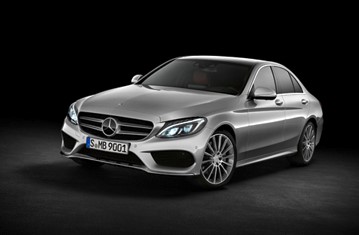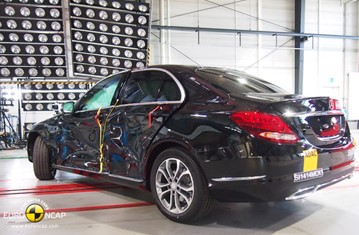Find more information in the General Comments section of the assessment
Find more information in the Rating Validity tab of the assessment
- See More
- See More
- See More
- See More
- Good
- Adequate
- Marginal
- Weak
- Poor
 Passenger
Passenger
 Driver
Driver
 Rear Seat
Rear Seat
 Front Seat
Front Seat
 Car
Car
 Pole
Pole
- Good
- Adequate
- Marginal
- Weak
- Poor


Passenger
outboard
center
Fitted to the vehicle as standard
Not fitted to the test vehicle but available as option
Not Available
-
Infants up to 13 kg
-
Infants and toddlers up to 18 kg
-
Toddlers from 9 to 18 kg
-
Toddlers over 18 kg
Easy
Difficult
Safety critical
Not allowed
| Seat Position | ||||
|---|---|---|---|---|
| Front | 2nd row | |||
| Passenger | Left | center | Right | |
| Maxi Cosi Cabriofix (Belt) | ||||
| Britax Römer King Plus (Belt) | ||||
| Britax Römer Duo Plus (ISOFIX) | ||||
| Britax Römer KidFix (Belt) | ||||
| Maxi Cosi Cabriofix & EasyFix (Belt) | ||||
| Maxi Cosi Cabriofix & EasyFix (ISOFIX) | ||||
| BeSafe iZi Kid X3 ISOfix (ISOFIX) | ||||
| Maxi Cosi Pearl & Familyfix (ISOFIX) | ||||
| Britax Römer KidFix (ISOFIX) | ||||
Easy
Difficult
Safety critical
Not allowed
Based on dummy readings in the dynamic tests, the C-Class scored maximum points for its protection of the 1 year infant. Forward movement of the head of the 3 year dummy, sat in a forward-facing restraint, was not excessive. However, chest loads indicated marginal level of protection for this part of the body, and neck forces were also high. In the side impact, both dummies were properly contained by the protective shells of their restraints, minimising the risk of head contact with parts of the car interior. The passenger airbag is automatically disabled when a rearward-facing child restraint is placed on the passenger seat. The system is different from previous Mercedes-Benz systems which only worked with specific seats. Clear information is provided to the driver regarding the status of the airbag and the system was awarded maximum points. All of the child restraints for which the car is designed could be properly fitted and accommondated by the car.
- Good
- Adequate
- Marginal
- Weak
- Poor

Head Impact 21.0 Pts
Pelvis Impact 0.8 Pts
Leg Impact 5.9 Pts
Nearly all of the tests performed on the bumper revealed a good level of protection being offered to pedestrians' legs. However, the front edge of the bonnet was poor in almost all tested areas and scored very few points. The C-Class has an 'active' bonnet for improved head protection. When an impact with a pedestrian is detected, actuators lift the bonnet, creating more space between it and the hard structures in the engine bay. Mercedes-Benz showed that the system worked robustly for pedestrians of different statures and at a wide range of speeds, so the system was tested in the deployed position. Results were good in almost all of the areas tested.
- Good
- Adequate
- Marginal
- Weak
- Poor
| Speed Limitation Function | Manually Set |
| System Name | ESP | |
| Performance | ||
| Applies To | All seats | ||
| Warning | Driver Seat | Front Passenger(s) | Rear Passenger(s) |
| Visual | |||
| Audible | |||
|
|||
| System Name | Collision Prevention Assist PLUS | |||
| Type | Forward Collision Warning with Auto-Brake | |||
| Operational From | 5 km/h | |||
| Additional Information | Default On | |||
| Performance | | ||||
| Autobrake Function Only | Driver reacts to warning | |||
| Operational Speed | 10-80 km/h | 5-100 km/h | ||
| Approaching a stationary car | See AEB City | Crash avoided up to 50km/h.Crash speed reduced up to 55km/h. | ||
| Approaching a slower moving car | Crash avoided up to 55km/h.Crash speed reduced up to 70km/h. | Crash avoided up to 80km/h.Crash speed reduced up to 0km/h. | ||
| Following a car at short distance | ||||
| Car in front brakes gently | Mitigation | Avoidance | ||
| Car in front brakes harshly | Mitigation | Mitigation | ||
| Following a car at long distance | ||||
| Car in front brakes gently | Mitigation | Avoidance | ||
| Car in front brakes harshly | Mitigation | Mitigation | ||
The C-Class has a seatbelt reminder system for the front and rear seats which met Euro NCAP's requirements. Electronic stability control is also standard equipment. A driver-set speed limitation device is optional but is expected to be fitted to most of the cars sold so was included in the assessment. The system met Euro NCAP's requirements for systems of this type. Collision Prevention Assist PLUS®, fitted as standard equipment, is an autonomous braking system that works at low speeds typical of city driving and at higher speeds, typical of the open road. The system was effective at avoiding collisions up to certain speeds and mitigating them (lowering the severity of the impact) at higher speeds. 'Lane Departure Warning' is also available on the C-Class as an option, as is an active system to help keep the driver in the lane ('Lane Departure Protection'), but these did not meet Euro NCAP's fitment criteria for inclusion in the assessment.
- Specifications
- Safety Equipment
- Videos
- Advanced Rewards
- Rating Validity
Specifications
Tested Model Mercedes-Benz C-Class C220 'Avantgarde', LHD
Body Type - 4 door sedan
Year Of Publication 2014
Kerb Weight 1570kg
VIN From Which Rating Applies - C-Class (from VIN WDD2050041F058500) and C-Class Coupé
Class Large Family Car
Safety Equipment
Note: Other equipment may be available on the vehicle but was not considered in the test year.
Fitted to the vehicle as standard
Fitted to the vehicle as option
Not fitted to the test vehicle but available as option
Not Available
Not Applicable
Videos
Advanced Rewards
Rating Validity








Find more information in the General Comments section of the assessment
 Share
Share









The passenger compartment remained stable in the frontal impact. Dummy readings indicated good protection of the knees and femurs of the driver and passenger dummies. Mercedes-Benz showed that a similar level of protection would be provided for occupants of different statures and those sat in different positions. in the side barrier test, good protection was provided for all body regions and the car scored maximum points. In the side impact, dummy readings of rib compression indicated a marginal level of protection for this part of the body. The protection offered by the front seats against whiplash injury in a rear-impact was good but a geometric assessment of the rear head restraints revealed a marginal level of protection.